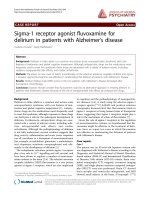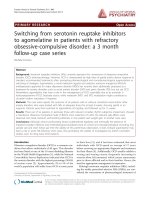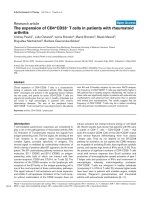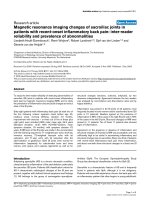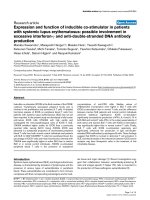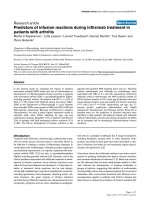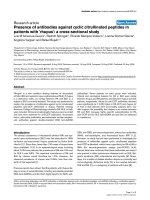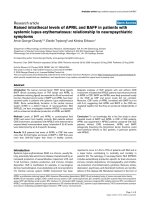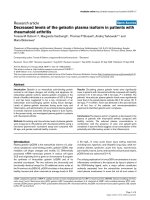Báo cáo y học: "Endothelial cell markers reflecting endothelial cell dysfunction in patients with mixed connective tissue disease" doc
Bạn đang xem bản rút gọn của tài liệu. Xem và tải ngay bản đầy đủ của tài liệu tại đây (781.75 KB, 11 trang )
Soltesz et al. Arthritis Research & Therapy 2010, 12:R78
/>Open Access
RESEARCH ARTICLE
BioMed Central
© 2010 Soltesz et al.; licensee BioMed Central Ltd. This is an open access article distributed under the terms of the Creative Commons
Attribution License ( which permits unrestricted use, distribution, and reproduction in
any medium, provided the original work is properly cited.
Research article
Endothelial cell markers reflecting endothelial cell
dysfunction in patients with mixed connective
tissue disease
Pal Soltesz
1
, Daniel Bereczki
2
, Peter Szodoray
3
, Maria T Magyar
4
, Henrietta Der
1
, Istvan Csipo
1
, Agota Hajas
1
,
Gyorgy Paragh
5
, Gyula Szegedi
1
and Edit Bodolay*
1
Abstract
Introduction: The aim of the present study was to investigate the association between cardiovascular risk factors and
endothelial dysfunction in patients with mixed connective tissue disease (MCTD) and to determine which biomarkers
are associated with atherosclerotic complications, such as cardiovascular disease.
Methods: Fifty MCTD patients and 38 healthy age-matched and sex-matched controls were enrolled in this study. In
order to describe endothelial dysfunction, we assessed flow-mediated dilation (FMD), nitrate-mediated dilation (NMD)
and carotid artery intima-media thickness (IMT). We investigated FMD of the brachial artery after reactive hyperemia
and NMD after sublingual nitroglycerin administration, while the IMT of the common carotid artery was determined by
ultrasound. Anti-U
1
ribonucleoprotein (anti-U
1
RNP) antibodies, anti-cardiolipin (anti-CL) antibodies, anti-endothelial
cell antibody (AECA) and endothelial cell markers, such as soluble thrombomodulin (TM) and von Willebrand factor
antigen (vWFAg), were assessed.
Results: The endothelium-dependent vasodilation (FMD) was significantly impaired in patients with MCTD, as
compared with controls (%FMD: 4.7 ± 4.2% vs. 8.7 ± 5.0%; P < 0.001), while the percentage NMD did not differ (%NMD:
14.3 ± 6.6% vs. 17.1 ± 6.7%; P = 0.073). Mean carotid IMT values were higher in patients than in controls (IMT: MCTD,
0.64 ± 0.13 mm vs. controls, 0.53 ± 0.14 mm; P < 0.001). FMD negatively correlated with disease duration, the levels of
apolipoprotein A
1
, the paraoxonase-1 activity, and systolic blood pressure in MCTD patients. The percentage FMD was
significantly lower in MCTD patients with cardiovascular diseases (CVD), than in those without CVD (%FMD: 3.5 ± 2.9 vs.
5.8 ± 4.8, P < 0.0002), while percentage NMD did not differ between patients with and without CVDs. Serum levels of
autoantibodies (anti-U
1
RNP, AECA and anti-CL) were significantly higher in MCTD patients and differed between MCTD
patients with and without CVD. Endothelial cell markers such as soluble TM (12.2 ± 8.1 ng/ml vs. 3.2 ± 1.3 ng/ml; P <
0.001) and vWFAg (224.1 ± 115% vs. 89.4 ± 27.1%, P < 0.001) were the highest in MCTD patients with CVD.
Conclusions: FMD is a reliable sensitive marker of endothelial cell dysfunction in MCTD. Beside the traditional risk
factors, anti-U
1
RNP, AECA and anti-CL antibodies may be important not only in the pathogenesis of MCTD but in the
induction of endothelial cell activation, and may play crucial roles in the development of early atherosclerosis in MCTD.
Introduction
Systemic autoimmune diseases, such as systemic lupus
erythematosus (SLE), rheumatoid arthritis or systemic
sclerosis, are chronic inflammatory disorders - signified
by complex interactions amongst traditional and nontra-
ditional disease-related phenomena, including inflamma-
tion, dyslipidemia, thrombotic events, and humoral
autoimmune processes [1-3]. Mixed connective tissue
disease (MCTD) is also a chronic inflammatory systemic
autoimmune disease, characterized by high titers of anti-
U
1
ribonucleoprotein (anti-U
1
RNP) antibodies [4-7].
The frank tissue inflammation and proliferating vascu-
lar arteriopathy is a specific feature of MCTD. Prolifera-
tive vasculopathy involves the small and large arteries in
* Correspondence:
1
3rd Department of Medicine, Medical and Health Science Center, University
of Debrecen, Moricz Zs. Str. 22, Debrecen 4032, Hungary
Full list of author information is available at the end of the article
Soltesz et al. Arthritis Research & Therapy 2010, 12:R78
/>Page 2 of 11
various organs. The lung is the most frequent predilec-
tion place of the vascular damage, however, and may
eventually lead to pulmonary arterial hypertension (PAH)
[8]. Our group and others found that PAH might be asso-
ciated with coexistent antiphospholipid and anti-
endothelial cell antibodies (AECAs) [9,10]. In our previ-
ous study we found that AECA provokes the surface
expression of E-selectin and the activation of endothelial
cells [11]. In sera of patients with PAH, high concentra-
tions of thrombomodulin (TM) and von Willebrand fac-
tor antigen (vWFAg) secreted from Weibel-Palade bodies
imply an activated state of the endothelial cells. TM - an
endothelial high-affinity receptor for thrombin - has an
anticoagulant effect, activating the protein C system [12].
Soluble TM can be measured in peripheral blood, and an
elevated level of soluble TM is a marker of endothelial
injury.
Previously we described high levels of total serum cho-
lesterol and reduced paraoxonase-1 (PON1) concentra-
tions and activity in patients'sera [13]. PON1 has an
antioxidant function, and it is a key factor in atheroscle-
rotic events [13].
These data suggest that patients with MCTD have the
traditional risk factors for the early development of ath-
erosclerosis. The connection between endothelial cell
damage and atherosclerosis in MCTD, however, has not
been described previously.
Endothelial dysfunction is both an early marker of vas-
cular diseases and a facilitating factor in the development
of atherosclerosis [14-16]. Flow-mediated dilatation
(FMD) of the brachial artery is a reliable and reproducible
non-invasive tool to evaluate endothelial function [17-
19]. The administration of sublingual nitrates is a good
test to examine the vasodilatatory effect of an exogenous
source of nitric oxide. The increase in carotid intima-
media thickness (IMT) is a useful marker of systemic sub-
clinical atherosclerosis and a strong predictor of subse-
quent myocardial infarction and stroke [20-22].
Since endothelial dysfunction represents an early stage
of atherogenesis, the aim of this study was to determine
whether impaired FMD amongst other biomarkers of
endothelial dysfunction, is characteristic of patients with
MCTD.
We aimed to determine which factors are associated
with cardiovascular events in MCTD. We also investi-
gated the endothelial cell functions, especially FMD,
together with the circulating endothelial cell markers,
soluble TM and vWFAg, reflecting the state of activation/
damage of the endothelium. Finally, we investigated the
relationship between peripheral endothelial dysfunction
and carotid IMT.
Materials and methods
Patients
Fifty women with MCTD, treated and followed-up at the
3rd Department of Internal Medicine, University of
Debrecen, were enrolled in the present study. Of these, 23
women (46%) had a history of cardiovascular diseases
(CVDs). CVD was diagnosed if: the patient had acute
myocardial infarction, or had ECG signs of myocardial
infarction, recorded semi-annually; the coronary disease
was treated with coronary bypass operation or angio-
plasty; or angina was verified by angiography and/or the
ischemic alterations were verified by a non-invasive test
or tissue Doppler's examination. Twenty-seven female
MCTD patients without CVD were included and denoted
as the MCTD/CVD-negative group.
All patients fulfilled the criteria for MCTD according to
Alarcon-Segovia and Villarreal [23]. Clinical disease
activity was assessed by the systemic lupus activity mea-
sure (SLAM) retrospectively from the patients' reports
[24,25]. A SLAM value >6 was considered high disease
activity.
MCTD patients were followed-up every 4 months at
the outpatient clinic. Diagnostic procedures for MCTD
included X-ray scan, lung function tests, electromyogra-
phy and electroneurography. Esophageal involvement
was detected by radionuclid esophageal transit scintigra-
phy and radiographic passage using gastrographin, or
barium. Myositis was confirmed by muscle biopsy and/or
electromyogram and creatinine kinase elevation. Ray-
naud's phenomenon was assessed by a positive color
chart or cold test, and morphological abnormalities were
assessed by nailfold capillary microscopy (Nikon Corp.,
Vienna, Austria).
Abnormal findings were assessed, as earlier described
by Maricq [26]. Abnormal findings were as follows: num-
ber of loops in a linear 1 mm width, enlargement of capil-
lary loops, or presence of bushy capillaries and avascular
areas. Avascularization was assessed by methods
described by Lee and colleagues [27]. The scleroderma
pattern was characterized by nailfold microhemorrhages,
enlarged loops, and avascular areas.
In laboratory analyses, we assessed the erythrocyte sed-
imentation rate (ESR), high-sensitivity C-reactive protein
(hs-CRP), the routine blood count, and the renal and liver
function; urine analysis was also performed. Traditional
risk factors for cardiovascular disease such as age, body
mass index (BMI), fasting plasma glucose, plasma lipid
levels, as well as blood pressure were recorded.
Thirty-eight age-matched and BMI-matched female
control subjects were also enrolled in the study. Exclusion
criteria included known CVD, diabetes mellitus, obesity
(BMI >30), and infection. Patients and controls had not
consumed alcohol or taken vasoactive drugs within the
Soltesz et al. Arthritis Research & Therapy 2010, 12:R78
/>Page 3 of 11
past 24 hours. No patients received lipid-lowering thera-
pies 48 hours before the study.
Cumulative lifetime corticosteroid dose (prednisone
equivalent/grams) was calculated from hospital records.
Twenty-two out of 50 patients with MCTD received non-
steroidal anti-inflammatory drugs, 10 patients had the
combination of corticosteroids (CS) and salazopyrine,
and 11 patients received a combination therapy of CS and
methotrexate, while seven patients received CS therapy
alone.
The protocol was in full compliance with the Good
Clinical Practices, the Declaration of Helsinki, and the
guidelines of the Medical and Health Science Centre of
the University of Debrecen. The protocol has been
approved by the institutional ethics committee (Regional
and Institutional Ethics Committee, Medical and Health
Science Centre, University of Debrecen). Written
informed consent was obtained from all patients and
healthy controls.
Immunoserological investigations
The detection of antinuclear antibodies on the HEp2 cell
line was carried out by indirect immunofluorescence.
The serum concentrations of autoantibodies were ana-
lyzed by ELISA according to the manufacturer's instruc-
tions: anti-Sjögren syndrome-associated antigen A
antibodies, anti-Sjögren syndrome-associated antigen B
antibodies, anti-Sm antibodies, anti-Sc170 antibodies,
anti-dsDNA antibodies, anti-cardiolipin (anti-CL) anti-
bodies (Cogent Diagnostic, Edinburgh, UK), and anti-
U
1
RNP antibodies (Pharmacia and Upjohn, Freiburg,
Germany). Absorbances were measured by a Labsystems
Multiscan MS ELISA reader at 492 nm (Labsystems Oy,
Helsinki, Finland). The concentrations of samples were
determined using a standard curve obtained from the
optical densities of standards with known concentration.
Endothelial cell markers
Thrombomodulin levels were measured by ELISA using
commercial reagents according to the manufacturer's
instructions (Diagnostic Stago, Asnieres, France). All
assays were performed in duplicate. The intra-assay and
interassay coefficients of variation for all ELISA assays
were <5% and <10%, respectively.
The assessment of AECAs was performed on endothe-
lial cells from human umbilical cord veins, employing an
ELISA method, described previously in detail [11].
Laboratory examinations
The total cholesterol concentration was determined spec-
trophotometrically. Triglyceride and high-density lipo-
protein cholesterol (HDL-C) was measured with the
immune turbidimetric method. Low-density lipoprotein
cholesterol (LDL-C) was measured by homogenous,
enzymatic, colorimetric assay (Roche LDL-C plus 2nd
generation; Roche, Basel, Switzerland).
Apolipoprotein A
1
(ApoA
1
) and apolipoprotein B were
assessed with the Orion Diagnostica kit (Orion Diagnos-
tica, Espoo, Finland), which employs an immune-neph-
elometric method. PON1 activity was measured
spectrophotometrically [13].
Endothelium-dependent (flow-mediated) and
endothelium-independent (nitrate-mediated) vasodilation
Endothelium-dependent vasodilation was assessed with a
7.5-MHz linear array transducer (Hewlett-Packard Sonos
5500; Soma Technology Inc., Bloomfield, CT, USA) by
scanning the brachial artery in longitudinal sections, as
published previously [28]. Endothelial function testing
was performed by the same person (HD) and the evalua-
tion was carried out offline by a digital software tech-
nique (AVITA; Gtech Information Systems, Naperville,
IL, USA), as described previously in detail [29].
The inter-observer analysis found the variability on 20
patients to be 8.95%. The intra-observer analysis was per-
formed on 10 healthy individuals three times, with a 30-
minute interval between the analyses. The intra-observer
variability was 4.6%. We performed the variation coeffi-
cient for baseline diameter in 20 cases, and it was 0.86%;
the accuracy of the method is therefore appropriate
according to the international recommendation [30].
Carotid duplex ultrasound investigations; measurement of
carotid artery intima-media thickness
Ultrasound examinations were performed immediately
after bloodsampling with the color-coded Hewlett Pack-
ard SONOS 5500 (Soma Technology Inc.) carotid duplex
equipment with a 7.5 MHz linear transducer. The investi-
gation included longitudinal and transverse examination-
sof the carotid arteries. Measurements of IMT were
performed at about 10 mm proximalto the carotid bulb,
or at 20 mm proximal to the flow divider. The IMTwas
measured as the distance between the leading edge of the
first echogenicline (lumen-intima interface) and the sec-
ond echogenic line(upper layer of the adventitia) in the
far (deeper) artery wall. All measurements were per-
formed at the end of the heart cycle, when the transduc-
erwas in the mediolateral direction [31]. Offline analysis
was performed by digital video images (AVITA; Gtech
Information Systems). Measurements were performedin
both carotid arteries and the larger of the two values was
used for analysis.
Statistical analysis
Normality of continuous variables was evaluated by the
Shapiro-Wilk test. As most variables were not normally
distributed, the Mann-Whitney test was used to compare
controls and MCTD patients. Factors that differed signif-
Soltesz et al. Arthritis Research & Therapy 2010, 12:R78
/>Page 4 of 11
icantly between patients and controls in univariate tests
were entered in a general linear model to test whether
these factors are independent predictors of FMD, nitrate-
mediated dilation (NMD) and IMT. Statistica for Win-
dows (StatSoft, Tulsa, OK, USA) was used for data analy-
sis. Correlations were determined using Spearman
correlation coefficient. Statistical significance was
assumed when P < 0.05.
Results
In the patient group the mean ± standard deviation age at
the time of investigation was 50.2 ± 10.0 years (range: 17
to 69 years) and the disease duration was 9.56 ± 6.8 years
(range: 3 to 26 years). Patients with MCTD and the con-
trol group were similar with regards to age, systolic and
diastolic blood pressures, triglyceride, LDL-C, HDL-C, as
well as BMI (Table 1). The total cholesterol (P < 0.047),
the PON1 activity (P < 0.001) and ApoA
1
levels (P <
0.001) were significantly lower in MCTD patients than in
the controls, while there was no difference in apolipopro-
tein B concentrations between patients with MCTD and
controls (P = 0.693). The ApoA
1
and PON1 activities
were lower in the MCTD/CVD
+
and MCTD/CVD
-
patient groups compared with controls. The ESR and hs-
CRP levels were significantly higher in patients with
MCTD and in the MCTD/CVD
+
and MCTD/CVD
-
groups compared with healthy controls.
The involvement of various organs is summarized in
Table 2. The presence of Raynaud's phenomenon (P <
0.006), PAH (P = 0.0141), and secondary antiphospho-
lipid syndrome (P = 0.015) were significantly more fre-
quent in MCTD/CVD
+
patients than in the MCTD/CVD
-
patient group.
Concerning autoantibody profiles, all of the patients
were positive for antinuclear antibodies and anti-U
1
RNP
antibodies, 19 patients (38%) had anti-CL antibodies (IgG
or IgM anti-CL antibodies), and 22 patients (44%) were
positive for AECAs. The frequency of anti-CL-positive
and AECA-positive patients was significantly higher in
the MCTD/CVD
+
group (anti-CL, P = 0.0195; AECA, P <
0.001).
The ratio of patients taking CS at the time of the study,
the cumulative median dose of CS, and other medications
are also presented in Table 2.
Raynaud's phenomenon was detected in 39 out of 50
patients with MCTD. In the MCTD/CVD
+
group, 22
Table 1: Baseline characteristics of patients
Feature
MCTDa
Controls P value, MCTD
vs. controls
MCTDb CVD+
MCTD CVD-
P value, MCTD/
CVD+ vs. MCTD/
CVD-
n 50 38 23 27
Age at investigation (years) 50.2 ± 10.0 50.4 ± 10.3 0.936 50.1 ± 10.7 50.2 ± 9.5 0.99
Disease duration (years) 9.56 ± 6.8 (3 to 26) - - 10.3 ± 6.6 (3 to 26) 8.9 ± 6.9 (3 to 25) 0.481
SBP (mmHg) 137.4 ± 21.1 132.9 ± 19.6 0.367 144.7 ± 19.5 131.1 ± 20.6 0.037
DBP (mmHg) 90.9 ± 15.9 86.6 ± 15.3 0.215 88.5 ± 14.9 92.9 ± 16.8 0.299
BMI (kg/m
2
) 24.2 ± 1.3 23.2 ± 1.1 0.77 23.9 ± 1.1 24.81.9 0.383
Smoking
Former smokers 5 (10%) 5 (13.1) 0.7401 2 (8.6) 3 (11.1) 1.0
Nonsmokers 45 (90%) 33 (86.8%) 0.7401 21 (91.3) 24 (88.8) 1.0
Serum triglyceride (mmol/l) 1.611 ± 0.76 1.6 ± 0.79 0.755 1.5 ± 0.82 1.72 ± 0.70 0.3367
Total cholesterol (mmol/l) 5.94 ± 1.18 5.47 ± 1.03 0.047 5.8 ± 1.2 6.06 ± 1.13 0.108
HDL-C (mmol/l) 1.69 ± 0.5 1.68 ± 0.49 0.943 1.56 ± 0.48 1.8 ± 0.5 0.22
LDL-C (mmol/l) 3.62 ± 1.15 3.23 ± 0.88 0.148 3.52 ± 1.19 3.7 ± 1.12 0.333
ApoA
1
(g/l) 1.31 ± 0.36 1.72 ± 0.47 <0.001 1.27 ± 0.3 1.33 ± 0.4 0.003
ApoB (g/l) 0.95 ± 0.31 0.91 ± 0.13 0.693 0.98 ± 0.38 0.89 ± 0.15 0.92
Paraoxonase-1 activity 113.6 ± 70.6 187.4 ± 68.3 <0.001 84.32 ± 69.66 138.7 ± 62.3 <0.001
hs-CRP (mg/l) 15.2 ± 9.62 1.44 ± 0.99 <0.001 22.1 ± 9.78 9.36 ± 3.96 <0.001
ESR (mm/hour) 20.2 ± 17.8 8.3 ± 3.9 <0.001 26.5 ± 17.6 14.4 ± 16.2 0.014
ApoA
1
, apolipoprotein A
1
; ApoB, apolipoprotein B; BMI, body mass index; CVD, cardiovascular disease; DBP, diastolic blood pressure; ESR:
erythrocyte sedimentation rate; HDL-C, high-density lipoprotein-cholesterol; hs-CRP: high-sensitivity C-reactive protein; LDL-C, low-density
lipoprotein-cholesterol; MCTD, mixed connective tissue disease; SBP, systolic blood pressure.
a
Mann-Whitney U test.
b
Kruskal-Wallis analysis of
variance.
Soltesz et al. Arthritis Research & Therapy 2010, 12:R78
/>Page 5 of 11
Table 2: Clinical symptoms of mixed connective tissue disease patients with and without cardiovascular diseases
MCTD manifestation MCTD (n = 50) MCTD/CVD+ (n = 23) MCTD/CVD- (n = 27) P valuea, CVD+ vs. CVD-
Disease duration (years) 9.56 ± 6.8 (3 to 26) 10.3 ± 6.6 (3 to 26) 8.9 ± 6.9 (3 to 25) 0.481
Polyarthritis 46 (92) 22 (95.6) 24 (88.8) 0.6123
Raynaud's phenomenon 39 (78) 22 (95.6) 17 (62.9) 0.006
Myositis 30 (60) 13 (56.5) 17 (62.9) 0.8621
Interstitial lung disease 40 (80) 19 (82.6) 21 (77.7) 0.7356
Photosensitivity 12 (24) 7 (30.4) 5 (18.5) 0.5077
Esophageal dysmotility 35 (70) 15 (65.2) 20 (74.0) 0.5480
Pulmonary arterial hypertension 12 (24) 9 (39.1) 3 (11.1) 0.0141
Lymphadenomegaly 13 (0.26) 5 (21.7) 8 (29.6) 0.7474
Serositis 19 (38) 11 (47.8) 8 (29.6) 0.2465
Secondary antiphospholipid syndrome 15 (30) 11 (47.8) 4 (14.8) 0.015
Previous venous thrombosis 13 (26.0) 9 (39.1) 4 (14.8) 0.618
Previous arterial occlusion 2 (4.0) 2 (8.69) 0
Anti-U
1
RNP (normal: <10 U/ml) 50 (100) 23 (100) 27 (100)
Anti-CL IgG/IgM (normal: <10 U/ml) 19 (38) 13 (56) 6 (22) 0.0195
AECA (normal: <5 U/ml) 22 (44) 15 (65) 7 (26) 0.001
SLAM (median) 5 5 4
SLAM (mean ± SD) 6.28 ± 4.04 6.95 ± 4.08 5.44 ± 4.0 0.199
SLAM (n) 18 (36) 11 (47.8) 7 (25.9) 0.1438
Medication
Nonsteroidal anti-inflammatory
drugs
22 (44) 10 (43.4) 12 (44.4) 1.0
Last 2 months average dose of
corticosteroids (mg/day)
3.36 ± 4.8 4.1 ± 3.4 3.1 ± 5.2 0.5306
Cumulative lifetime dose
(prednisone equivalent)
14.21 (4 to 58.965) 13.0 (4 to 59.432) 15.2 (4 to 57.437) 0.674
Corticosteroids alone or
combination (n)
28 (56) 11 (47.8) 17 (62.9) 0.3926
Patients currently
corticosteroids alone n (%)
7 (14) 2 (8.6) 5 (18.5) 0.4295
Patients currently
corticosteroids plus salazopyrine
10 (20) 5 (21.7) 5 (18.5) 1.0
Patients currently
corticosteroids plus
methotrexate
11 (22) 5 (21.7) 6 (22.2) 1.00
Cyclophosphamide treatment ever 37 (74) 21 (91.3) 16 (59.2) 0.0119
Antimalaric drugs treatment ever 39 (78) 19 (82.6) 20 (74.0) 0.515
Cyclosporin-A treatment ever 10 (20) 7 (30.4) 3 (11.1) 0.4804
Data presented as mean ± standard deviation, n (%) or median (25th to 75th percentile). AECA, anti-endothelial cell antibody; anti-CL, anti-
cardiolipin; anti-U
1
RNP, anti-U
1
ribonucleoprotein; CVD, cardiovascular disease; MCTD, mixed connective tissue disease. The systemic lupus
erythematosus disease activity measure (SLAM) is a measure of disease activity [24,25].
a
Fischer's exact test and Student t test.
patients had Raynaud's phenomenon. Among these, 10
patients' sera contained anti-CL IgG/IgM antibodies,
while 13 patients' sera were AECA-positive. An associa-
tion was found between Raynaud's phenomenon and
anti-CL IgG/IgM (P < 0.03), and between Raynaud's phe-
nomenon and the presence of AECA (P < 0.02).
Percentage FMD, percentage NMD, IMT, autoantibodies
and endothelial cell markers
Anti-U
1
RNP autoantibodies, anti-CL IgG/IgM type
autoantibodies, AECA and both endothelial cell markers
(TM and vWFAg) were significant increased in MCTD
Soltesz et al. Arthritis Research & Therapy 2010, 12:R78
/>Page 6 of 11
patients versus controls and in the MCTD/CVD
+
versus
MCTD/CVD
-
patient groups (Table 3).
Percentage FMD was significant lower in MCTD
patients compared with controls and in MCTD/CVD
+
patients versus MCTD/CVD
-
patients (%FMD: MCTD,
4.7 ± 4.2% vs. controls, 8.7 ± 5.05%, P < 0.001; MCTD/
CVD
+
vs. MCTD/CVD
-
, P < 0.0002). Percentage NMD
did not show a difference between MCTD and controls
and between the MCTD/CVD
+
versus MCTD/CVD
-
patient groups.
The IMT was significantly higher both in the MCTD
patients and in the MCTD/CVD
+
vs. MCTD/CVD
-
patients (IMT: MCTD, 0.64 ± 0.13 mm vs. controls, 0.53
± 0.14 mm, P < 0.001; MCTD/CVD
+
vs. MCTD/CVD
-
, P
< 0.001).
Correlation between flow-and nitrate mediated
vasodilation, IMT and other measured parameters in MCTD
patients
A significant negative correlation was found between
percentage FMD and the disease duration (r = -0.6468, P
< 0.001), and between percentage FMD and systolic
blood pressure (r = -0.5423, P < 0.001) (Table 4). There
was a positive correlation between percentage FMD and
ApoA
1
levels, and percentage FMD and PON1 activity
(ApoA
1
: r = 0.6203, P < 0.001; PON1 activity: r = 0.5957, P
< 0.001). Significant correlation was found between per-
centage FMD and AECA (r = -0.3075, P = 0.029), and
between percentage FMD and inflammatory parameters
such as the ESR (r = -0.4283, P < 0.001) and hs-CRP (r = -
0.4057, P = 0.003).
We found a negative correlation between SLAM score
and percentage FMD (r = -0.488, P < 0.001) (Figure 1).
NMD showed a negative association with hs-CRP (r = -
0.3207, P = 0.023) and the ESR (r = -0.3981, P < 0.001). No
other correlations were detected.
The IMT was significantly higher in MCTD patients
compared with controls (0.64 mm vs. 0.53 mm; P <
0.001). The IMT was age dependent (r = 0.5468, P <
0.001), and showed an association with serum levels of
anti-U
1
RNP autoantibodies (P = 0.0025) and AECA (P =
0.0417), the endothelial cell markers TM (P <0.001) and
vWFAg (P < 0.001), and the ESR (P < 0.001) and hs-CRP
(P < 0.001).
In our patients we found a correlation between the ESR
and hs-CRP (r = 0.511, P < 0.001). In the MCTD/CVD
+
group, 22 patients had Raynaud's phenomenon. Evalua-
tion of the relationship between MCTD patients with
Raynaud's phenomenon and FMD is presented in Table 5.
There was a significant association in MCTD patients
with and without Raynaud's phenomenon and FMD.
There was a negative association between FMD and
MCTD patients with Raynaud's phenomenon in the
CVD
+
and CVD
-
groups.
Discussion
Cardiovascular diseases have recently been shown to be
the leading causes of morbidity and mortality in patients
with systemic autoimmune diseases. Some evidence
shows that in autoimmune disorders, such as SLE, rheu-
matoid arthritis and antiphospholipid syndrome, the sys-
temic inflammatory state itself predisposes to
atherosclerotic diseases [32-35].
MCTD is a systemic autoimmune disease, involving
many organs, while the most frequent, serious outcome is
the development of proliferative vascular lesions in the
lungs and other organs. Anti-U
1
RNP autoantibodies may
Table 3: Autoantibodies, endothelial cell parameters, FMD, NMD and IMT in MCTD patients with/without cardiovascular
diseases
Feature MCTD (n = 50) Controls (n = 38) P value,
MCTD vs.
controlsa
MCTD/CVD+ (n = 23) MCTD/CVD- (n = 27)
P value, MCTD/
CVD+ vs.
MCTD/CVD-b
Anti-U
1
RNP (U/ml) 20.18 ± 14.6 8.02 ± 3.5 <0.001 30.3 ± 14.6 11.51 ± 7.28 <0.001
Anti-CL IgG/IgM (U/ml) 13.98 ± 12.2 6.06 ± 2.93 <0.001 21.02 ± 15.04 7.98 ± 2.95 <0.001
AECA (IU/ml) 50.1 ± 34.5 17.1 ± 8.48 <0.001 62.9 ± 26.3 39.1 ± 37.2 <0.001
Thrombomodulin (ng/ml) 12.2 ± 8.1 3.2 ± 1.3 <0.001 15.9 ± 5.2 9.0 ± 8.8 <0.001
vWFAg (%) 224.1 ± 115 89.4 ± 27.1 <0.001 311.5 ± 72.0 149.7 ± 90.0 <0.001
FMD (%) 4.76 ± 4.2 8.74 ± 5.05 <0.001 3.54 ± 2.9 5.81 ± 4.87 0.0002
NMD (%) 14.35 ± 6.67 17.16 ± 6.7 0.073 13.54 ± 6.06 15.03 ± 7.15 0.1283
IMT (mm) 0.64 ± 0.13 0.53 ± 0.14 <0.001 0.72 ± 0.11 0.57 ± 0.1 <0.001
AECA, anti-endothelial cell antibody; anti-CL, anti-cardiolipin; anti-U
1
RNP, anti-U
1
ribonucleoprotein; CVD, cardiovascular disease; FMD, flow-
mediated dilation; IMT, intima-media thickness; MCTD, mixed connective tissue disease; NMD, nitrate-mediated dilation; vWFAg, von Willebrand
factor antigen.
a
MCTD and controls, Mann-Whitney U test.
b
MCTD/CVD
+
and MCTD/CVD
-
, analysis of variance test.
Soltesz et al. Arthritis Research & Therapy 2010, 12:R78
/>Page 7 of 11
have an effect on endothelial cells; in some studies on
MCTD, however, the presence of antiphospholipid or
anti-endothelial antibodies, in addition to anti-RNP anti-
bodies, showed functional properties such as endothelial
cell activation - changing the phenotype of endothelial
cells, which become proinflammatory/procoagulant [36].
No previous studies, however, have been carried out to
assess the atherosclerotic risk factors in MCTD patients.
In our study population, we investigated the traditional
risk factors, in association with clinical symptoms and
autoantibodies, in MCTD patients with and without car-
diovascular events. This is the first study where endothe-
lial stiffness markers are measured, including FMD, NMD
and carotid IMT.
In our patients with MCTD, serum triglycerides, HDL-
C and LDL-C did not differ from healthy subjects, while
total cholesterol and the ApoA
1
levels and serum PON1
activity within the liporpotein fraction were lower com-
pared with controls.
Decreased PON1 activity and mild elevation in hs-CRP
have drawn considerable interest, in relation to the devel-
opment of atherosclerosis that exemplifies a low-grade
chronic inflammatory process [37,38].
Decreased percentage FMD and increased IMT was
found in patients with MCTD. Our results indicated that
reduced FMD can clearly distinguish MCTD patients
from controls and, moreover, MCTD patients with and
without cardiovascular events. Decreased percentage
FMD showed a close correlation with the disease dura-
tion, systolic blood pressure, and inflamatory parameters
(hs-CRP and ESR).
High serum levels of hs-CRP have been shown to have a
close association with CVDs, representing a link between
chronic inflammation and hs-CRP with athrerosclerosis
[39]. A strong correlation was described between hs-CRP
and CVD events, when hs-CRP exceeded 3 mg/l [40]. In
our series, both hs-CRP and the ESR were elevated in
MCTD patients, escpecially in the MCTD/CVD
+
group,
and percentage FMD showed a close negative correlation
with elevated ESR. These results may suggest that MCTD
patients have ongoing low-grade inflammation, and these
patients have an increased risk of severe CV events. A
close association between SLAM score and percentage
FMD shows that the disease activity involves endothelial
cell inflammation, causing endothelial cell dysfunction.
Serum concentration of anti-U
1
RNP autoantibodies
and levels of AECA were elevated in the patients'sera, and
both antibodies were higher in the MCTD/CVD
+
patients
compared with the MCTD/CVD
-
group. Furthermore, we
showed that the markers of endothelial cell dysfunction,
vWFAg and soluble TM were higher in patients with
MCTD than in the healthy individuals.
In MCTD, high serum levels of vWFAg imply an acti-
vated state of endothelial cells and can play a pathogenic
Table 4: FMD, NMD and IMT in MCTD patients with/without cardiovascular disease and controls
%FMDa
P value
%NMDa
P value
IMTa
P value
Age at investigation (years) -0.0221 0.878 -0.6700 0.001 0.5468 0.001
Disease duration (years) -0.6468 0.001 -0.1314 0.3628 0.1968 0.1706
Systolic blood pressure (mmHg) -0.5423 0.001 -0.1094 0.4492 0.2220 0.1211
Diastolic blood pressure (mmHg) 0.0946 0.5133 0.1005 0.4872 -0.1597 0.2676
Serum triglycerides (mmol/l) -0.3396 0.0158 0.2165 0.1309 -0.0411 0.7765
Serum cholesterol -0.0459 0.7514 0.0508 0.7255 -0.0209 0.8851
Apolipoprotein A
1
(g/l) 0.6203 0.001 -0.0805 0.5782 -0.0248 0.8640
Apolipoprotein B (g/l) -0.3102 0.061 -0.0891 0.5997 0.0767 0.6517
Paraoxonase-1 activity 0.5957 0.001 0.1317 0.3619 -0.2789 0.0497
hs-CRP -0.4057 0.003 -0.3207 0.023 0.7164 0.001
ESR -0.4283 0.001 -0.3981 0.001 0.5467 0.001
Anti-U
1
RNP (U/ml) -0.0486 0.7371 -0.0694 0.6316 0.4182 0.0025
Anti-CL IgG (U/ml) -0.0717 0.6206 -0.0411 0.776 0.2236 0.1184
AECA (IU/ml) -0.3075 0.029 -0.2686 0.0592 0.2890 0.0417
Thrombomodulin (ng/ml) -0.0642 0.6577 -0.0165 0.9089 0.4823 0.00038
vWFAg (%) -0.0122 0.9329 -0.2692 0.058 0.5443 0.001
AECA, anti-endothelial cell antibody; anti-CL, anti-cardiolipin; anti-U
1
RNP, anti-U
1
ribonucleoprotein; ESR, erythrocyte sedimentation rate;
FMD, flow-mediated dilation; hs-CRP, high-sensitivity C-reactive protein; IMT, intima-media thickness; MCTD, mixed connective tissue
disease; NMD, nitrate-mediated dilation; vWFAg, von Willebrand factor antigen.
a
Spearman rank correlation.
Soltesz et al. Arthritis Research & Therapy 2010, 12:R78
/>Page 8 of 11
role in the development of atherothrombotic events [41].
Accordingly, in MCTD/CVD
+
patients the soluble TM
levels were significant higher than in the MCTD/CVD
-
group. TM is an endothelial cell activation marker, and its
shedding from the endothelial cell increases the risk of
cardiovascular and thrombotic events [12,42].
In patients with atherosclerotic diseases, soluble TM
was elevated and its level showed correlation with the
severity of coronary artery disease, and also an associa-
tion with worse outcome in survivals after acute myocar-
dial infarction [42]. Moreover, soluble TM is a good
marker of disease activity in SLE with lupus nephritis
[43].
vWFAg is a circulating glycoprotein, synthesized by
endothelial cells - and an increased serum concentration
of vWFAg has been shown to be a marker of endothelial
dysfunction in scleroderma, SLE and MCTD patients
with PAH [10,44].
In our patients with MCTD, percentage FMD strongly
correlated with disease duration, autoantibodies to anti-
U
1
RNP, AECA and anti-CL, and endothelial cell markers,
such as TM and vWFAg. These data indicate that the
reduced FMD is a good marker for monitoring cardiovas-
cular complications in MCTD.
One of the earliest stages of atherosclerosis is the
endothelial cell dysfunction [45]. Endothelium-depen-
dent FMD was described previously to be significantly
impaired in SLE [34], in rheumatoid arthritis [35], and in
antiphospholipid syndrome [29]. In our earlier study we
also found decreased FMD in patients with undifferenti-
ated connective tissue disease (UCTD), which is an early
stage of well-established connective tissue diseases [46].
Mosca and colleagues also investigated the vascular reac-
tivity in UCTD, and found that FMD and the response to
glyceryl trinitrate-mediated vasodilation were similar in
UCTD patients and healthy subjects. UCTD patients
were characterized, however, by having reduced response
to both acethylcholine and sodium nitroprusside in the
forearm microcirculation, indirectly indicating that
reduced endothelium-dependent vasodilation, a periph-
eral microvascular risk factor, signifies UCTD [47].
In the present study we found that FMD decreased and
the IMT was elevated in the MCTD/CVD
+
patient group,
but there was no significant difference in NMD between
the MCTD/CVD
+
and MCTD/CVD
-
patient groups. We
further described the presence of anti-CL antibodies and
AECA besides anti-U
1
RNP antibodies in MCTD; more-
over, serum levels of anti-U
1
RNP antibodies, anti-CL IgG
and AECA were higher in the MCTD/CVD
+
group com-
pared with MCTD/CVD
-
patients.
We assume that AECA in MCTD patients could con-
tribute to endothelial cell dysfunction. AECAs are often
associated with phospholipid reactivity, present in SLE
and in primary antiphospholipid syndrome.
In contrast to the data by Lima and colleagues, we
found that FMD showed a correlation with the activity
score [48]. Among the clinical symptoms, Raynaud's phe-
nomenon was more frequent in the MCTD/CVD
+
group
- our data being similar to the findings of Aizer and col-
leagues [49]. Interestingly, anti-CL antibodies and
AECAs were more frequent in patients with Raynaud's
phenomenon, and these antibodies could provoke
Figure 1 Activity score and flow-mediated dilation in patients with mixed connective tissue disease. Y axis: flow-mediated dilation (%). X axis:
systemic lupus activity measure score (number).
5.00
10.00
15.00
20.00
r=-0.488
p<0.001
Soltesz et al. Arthritis Research & Therapy 2010, 12:R78
/>Page 9 of 11
endothelial cell damage. We assume that decreased FMD
may occur as a result of continuous endothelial cell acti-
vation and impairment.
The daily doses of CS and other immunosuppressive
treatment were similar in the CVD
+
and CVD
-
groups.
Based on our data we believe that the vascular protection
is essential in patients with MCTD, especially in Ray-
naud's penomenon and PAH, and also aspirin and statin
therapy is important from the early stage of MCTD.
Carotid IMT was significant higher in MCTD patients
and showed an association with age, with disease dura-
tion and with traditional risk factors such as total choles-
terol levels, systolic blood pressure and diastolic blood
pressure. Ultrasound measurements of the carotid artery
IMT identify early structural vascular abnormalities. An
inverse correlation has been described previously
between the IMT and brachial arterial FMD. Endothelial
dysfunction showed a correlation with the IMT, suggest-
ing that the carotid IMT alone was a valid surrogate
marker for early atherosclerosis and had an important
predicting feature in cardiovascular events in the general
population [50-52].
Conclusions
We state that, besides traditional atherosclerotic factors,
autoantibodies play a crucial role in early atherosclerosis
in MCTD. We believe that anti-U
1
RNP antibodies and
AECA, as well as the upregulation of proinflammatory
cytokines associated with vascular endothelial cell dam-
age, may play a pivotal role in the early atherosclerotic
events in MCTD.
We assume that vWFAg and TM are the most impor-
tant markers of endothelial cell activation, and they
impair endothelial cell functions. Finally, we found a clear
decrease of percentage FMD in MCTD patients with
CVD, cerebrovascular events, and peripheral arterial dis-
ease.
Our findings support the idea that the immune-medi-
ated endothelial dysfunction, accelerated atherosclerosis
present in patients with MCTD. We assume that the utili-
zation of these serum markers and non-invasive cardio-
vascular measurements in the diagnosis of early
atherosclerosis in MCTD provides a sufficient back-
ground for the early introduction of endothelial protec-
tion (for example, aspirin, statin) in the future
management of the disease, before the development of
serious cardiovascular symptoms.
Abbreviations
AECA: anti-endothelial cell antibody; anti-CL: anti-cardiolipin; anti-U
1
RNP: anti-
U
1
ribonucleoprotein; ApoA
1
: apolipoprotein A; BMI: body mass index; CVD:
cardiovascular disease; CS: corticosteroids; dsDNA: double-single DNA; ELISA:
enzyme-linked immunosorbent assay; ESR: erythrocyte sedimentation rate;
FMD: flow-mediated dilation; HDL-C: high-density lipoprotein-cholesterol; hs-
CRP: high-sensitivity C-reactive protein; IMT: intima-media thickness; LDL-C:
low-density lipoprotein-cholesterol; MCTD: mixed connective tissue disease;
NMD: nitrate-mediated dilation; PAH: pulmonary arterial hypertension; PON1:
paraoxonase-1; SLAM: systemic lupus activity measure; SLE: systemic lupus ery-
thematosus; TM: thrombomodulin; UCTD: undifferentiated connective tissue
disease; vWFAg: von Willebrand factor antigen.
Competing interests
The authors declare that they have no competing interests.
Authors' contributions
PSo performed acquisition and analysis of the data. DB and PSz performed
interpretation of the data and manuscript preparation. MTM, HD, IC and AH
performed interpretation of the data and drafted the manuscript. GP and GS
performed analysis and interpretation of the data. EB gave final approval of the
version to be published. All authors read and approved the final manuscript.
Acknowledgements
The present work was supported by research Grant Numbers ETT 260/2009,
ETT 197-05/2010 and ETT 158/2009 from the Ministry of Health, Republic of
Hungary.
Author Details
1
3rd Department of Medicine, Medical and Health Science Center, University of
Debrecen, Moricz Zs. Str. 22, Debrecen 4032, Hungary,
2
Department of
Neurology, Semmelweis University of Budapest, Balassa Str. 6, Budapest 1083,
Hungary,
3
Institute of Immunology, Rikshospitalet, University of Oslo,
Sognsvannsveien Str. 20, Oslo 0027, Norway,
4
Department of Neurology,
Medical and Health Science Center, University of Debrecen, Moricz Zs. Str. 22,
Debrecen 4032, Hungary and
5
1st Department of Medicine, Medical and
Health Science Center, University of Debrecen, Nagyerdei Str. 98, Debrecen
4032, Hungary
References
1. Sheerer Y, Shoenfeld Y: Mechanism of disease: atherosclerosis in
autoimmune diseases. Rheumatology 2006, 2:99-106.
2. Bijl M: Endothelial activation ,endothelial dysfunction and premature
atherosclerosis in systemic autoimmune diseases. Neth J Med 2003,
61:273-277.
3. Szucs G, Timar O, Szekanecz Z, Der H, Kerekes G, Szamosi S, Shoenfeld Y,
Szegedi G, Soltesz P: Endothelial dysfunction precedes atherosclerosis
in systemic sclerosis -relevance for prevention of vascular
complications. Rheumatology 2007, 46:759-762.
Received: 28 September 2009 Revised: 22 February 2010
Accepted: 6 May 2010 Published: 6 May 2010
This article is available from: 2010 Soltesz et al.; licensee BioMed Central Ltd. This is an open access article distributed under the terms of the Creative Commons A ttribution License ( which permits unrestricted use, distribution, and reproduction in any medium, provided the original work is properly cited.Arthritis R esearch & Thera py 2010, 12:R78
Table 5: Correlation between flow-mediated dilation and Raynaud's phenomenon
n
Correlationa
P value
MCTD with Raynaud's phenomenon 39/50 0.768 0.001
MCTD without Raynaud's phenomenon 11/50 0.25 0.235
Raynaud's phenomenon in MCTD/CVD
+
and MCTD/CVD
-
patients 22/17 0.522 0.001
CVD, cardiovascular disease; MCTD, mixed connective tissue disease.
a
Spearman correlation coefficient.
Soltesz et al. Arthritis Research & Therapy 2010, 12:R78
/>Page 10 of 11
4. Sharp GC: MCTD: a concept which stood the test of time. Lupus 2002,
11:333-339.
5. Pope JE: Other manifestations of mixed connective tissue disease.
Rheum Dis Clin North Am 2005, 31:519-533.
6. Aringer M, Steiner G, Smolen JS: Does mixed connective tissue disease
exist? Yes. Rheum Dis Clin North Am 2005, 31:411-420.
7. Greidinger EL, Foecking MF, Magee J, Wilson L, Ranatunga S, Ortmann RA,
Hoffman RW: A major B cell epitope present on the apoptotic but not
the intact form of the U1-70-kDa ribonucleoprotein autoantigen. J
Immunol 2004, 172:709-716.
8. Bull TM, Fagan KA, Badesh DB: Pulmonary vascular manifestations of
mixed connective tissue disease. Rheum Dis Clin North Am 2005,
31:451-464.
9. Hoffman RW, Greidinger EL: Mixed connective tissue disease. Curr Opin
Rheumatol 2000, 12:386-390.
10. Vegh J, Szodoray P, Kappelmayer J, Csipo I, Udvardy M, Lakos G, Aleksza M,
Soltesz P, Szilágyi A, Zeher M, Szegedi G, Bodolay E: Clinical and
immunoserological characteristics of mixed connective tissue disease
(MCTD) associated with pulmonary arterial hypertension (PAH). Scand
J Immunol 2006, 64:69-76.
11. Bodolay E, Csipo I, Gal I, Sipka S, Gyimesi E, Szekanecz Z, Szegedi G: Anti-
endothel cell antibodies in mixed connective tissue disease: frequency
and association with clinical symptoms. Clin Exp Rheumatol 2004,
22:409-415.
12. Conway EM, Wouwer M Van de, Pollefeyt S, Jurk K, Van Aken H, De Vriese
A, Weitz JI, Weiler H, Hellings PW, Schaeffer P, Herbert JM, Collen D,
Theilmeier G: The lectin-like domain of thrombomodulin confers
protection from neutrophil-mediated tissue damage by suppressing
adhesion molecule expression via nuclear factor kappaB and mitogen-
activated protein kinase pathway. J Exp Med 2002, 196:565-577.
13. Bodolay E, Seres I, Szodoray P, Csipo I, Jakab Z, Vegh J, Szilagyi A, Szegedi
G, Paragh G: Evaluation of paraoxonase activity in patients with mixed
connective tissue disease. J Rheumatol 2008, 35:237-243.
14. Ross R: Atherosclerosis an inflammatory disease. N Engl J Med 1999,
340:115-126.
15. Dzau VJ, Cooper T: Theodore Cooper Lecture: Tissue angiotensin and
pathobiology of vascular disease: a unifying hypothesis. Hypertension
2001, 37:1047-1052.
16. Shoenfeld Y, Gerli R, Doria A, Matsuura E, Cerinic MM, Ronda N, Jara LJ,
Abu-Shakra M, Meroni PL, Sherer Y: Accelerated atherosclerosis in
autoimmune rheumatic diseases. Circulation 2005, 112:3337-3347.
17. Corretti MC, Anderson TJ, Benjamin EJ, Celermajer D, Charbonneau F,
Creager MA, Deanfield J, Drexler H, Gerhard-Herman M, Herrington D,
Vallance P, Vita J, Vogel R, International Brachial Artery Reactivity Task
Force: Guidelines for the ultrasound assessment of endothelial-
dependent flow-mediated vasodilatation of the brachial artery: a
report of the International Brachial artery Reactivity Task Force. J Am
Coll Cardiol 2002, 16:257-265.
18. Celermajer DS, Sorensen KE, Gooch VM, Spiegelhalter DJ, Miller OI,
Sullivan ID: Non-invasive detection of endothelial dysfunction in
children and adults at risk of atherosclerosis. Lancet 1992,
340:1111-1115.
19. Benjamin EJ, Larson MG, Keyes MJ, Mitchell GF, Vasan RS, Keaney JF Jr,
Lehman BT, Fan S, Osypiuk E, Vita JA: Clinical correlates and heritability
of flow-mediated dilatation in the community: the Framingham Heart
Study. Circulation 2004, 109:613-619.
20. O'Leary DH, Polak JF, Kronmal RA, Manolio TA, Burke GL, Wolfson SK Jr:
Carotid-artery intima and media thickness as a risk factor for
myocardial infarction and stroke in older adults. Cardiovascular Health
Study Collaborative Research Group. N Engl J Med 1999, 340:14-22.
21. Burke GL, Evans GW, Riley WA, Sharrett AR, Howard G, Barnes RW,
Rosamond W, Crow RS, Rautaharju PM, Heiss G: Arterial wall thickness is
associated with prevalent cardiovascular disease in middle-aged
adults. The Atherosclerosis Risk in Communities (ARIC) Study. Stroke
1995, 26:386-391.
22. Bots ML, Hoes AW, Koudstaal PJ, Hofman A, Grobbee DE: Common
carotid intima-media thickness and risk of stroke and myocardial
infarction: the Rotterdam Study. Circulation 1997, 96:1432-1437.
23. Alarcon-Segovia DA, Villarreal M: Classification and diagnostic criteria for
mixed connective tissue disease. In Mixed Connective Tissue Disease and
Anti-nuclear Antibodies Edited by: Kasukawa R, Sharp GC. Amsterdam:
Excerpta Medica; 1987:33-40.
24. Liang MH, Socher SA, Roberts WN, Esdaile JM: Measurement of systemic
lupus erythematosus activity in clinical research. Arthritis Rheum 1988,
31:817-825.
25. Hassan AB, Gunnarson I, Karlsson L, Klareskog L, Forslid J, Lundberg IE:
Longitudinal study of interleukin-10, tumor necrosis factor-α anti-U1-
snRNP antibody levels and disease activity in patients with mixed
connective tissue disease. Scand J Rheumatol 2001, 30:282-289.
26. Maricq HR: Widefield capillary microscopy. Technique and rating scale
for abnormalities seen in scleroderma and related disorders. Arthritis
Rheum 1981, 24:1159-1165.
27. Lee P, Leung FY-K, Alderdice C, Armstrong SK: Nailfold capillary
microscopy in the connective tissue diseases: a semiquantitative
assessment. J Rheumatol 1983, 10:930-938.
28. Cines DB, Pollak ES, Buck CA, Loscalzo J, Zimmerman GA, McEver RP, Pober
JS, Wick TM, Konkle BA, Schwartz BS, Barnathan ES, McCrae KR, Hug BA,
Schmidt AM, Stern DM: Endothelial cells in physiology and in the
pathophysiology of vascular disorders. Blood 1998, 91:3527-3561.
29. Soltesz P, Der H, Veres K, Laczik R, Sipka S, Szegedi G, Szodoray P:
Immunological features of primary anti-phospholipid syndrome in
connection with endothelial dysfunction. Rheumatology (Oxford) 2008,
47:1628-1634.
30. Moens AL, Goovaerts I, Claeys MJ, Vrints CJ: Flow-mediated vasodilation.
A diagnostic instrument, or an experimental tool? Chest 2005,
127:2254-2263.
31. Kanters SDJM, Algra A, van Leeuwen MS, Banga JD: Reproducibility of in
vivo carotid intima-media thickness measurements. Stroke 1997,
28:665-671.
32. Manzi S, Meilahn EN, Rairie JE, Conte CG, Medsger TA Jr, Jansen-
McWilliams L, D'Agostino RB, Kuller LH: Age-specific incidence rates of
myocardial infarction and angina in women with systemic lupus
erythematosus: comparison with the Framingham Study. Am J
Epidemiol 1997, 145:408-415.
33. Gabriel S, Crowson C, O'Fallon WM: Heart disease in rheumatoid
arthritis. Arthritis Rheum 1998, 9:S132.
34. Kiss E, Soltesz P, Der H, Kocsis Z, Tarr T, Bhattoa H, Shoenfeld Y, Szegedi G:
Reduced flow-mediated vasodilation as a marker for cardiovascular
complications in lupus patients. J Autoimmun 2006, 27:211-217.
35. Szekanecz Z, Kerekes G, Der H, Sandor Z, Szabo Z, Vegvari A, Simkovics E,
Soos L, Szentpetery A, Besenyei T, Szucs G, Szanto S, Tamasi L, Szegedi G,
Shoenfeld Y, Soltesz P: Accelerated atherosclerosis in rheumatoid
arthritis. Ann N Y Acad Sci 2007, 1108:349-358.
36. Hoffman RW, Maldonado ME: Immune pathogenesis of mixed
connective tissue disease: a short analytical review. Clin Immunol 2008,
128:8-17.
37. Chait A, Han CY, Oram JF, Heinecke JW: Thematic review series: the
immune system and atherogenesis. Lipoprotein-associated
inflammatory proteins: markers or mediators of cardiovascular
disease? J Lipid Res 2005, 46:389-403.
38. Mackness B, Hine D, McElduff P, Mackness M: High C-reactive protein
and low paraoxonase1 in diabetes as risk factors for coronary heart
disease. Atherosclerosis 2006, 186:336-401.
39. Musunuru K, Kral BG, Blumenthal RS: The use of high-sensitivity assay for
C-reactive protein in clinical practice. Nat Clin Pract Cardiovasc Med
2008, 5:621-635.
40. Wilson PW, D'Agostino RB Sr, Sullivan L: Increased CRP and long term risk
for cardiovascular events in middle age men and women [abstract
4070]. Circulation 2006, 114 Suppl:II877-II878.
41. Svenungsson E, Cederholm A, Jensen-Urstad K, Faire GZ, Frostegard J:
Endothelial function and markers of endothelial activation in relation
to cardiovascular disease in systemic lupus erythematosus. Scand J
Rheumatol 2008, 37:352-359.
42. Chan SH, Chen JH, Li YH, Lin LJ, Tsai LM: Increasing post-event plasma
thrombomodulin level associates with worse outcome in survival of
acute coronary syndrome. Int J Cardiol 2006, 111:280-285.
43. Boehme MW, Nawroth PP, Kling E, Lin J, Amiral J, Riedesel J, Raeth U,
Scherbaum WA: Serum thrombomodulin. A novel marker of disease
activity in systemic lupus erythematosus. Arthritis Rheum 1994,
37:572-577.
44. Ho CY, Wong CK, Li EK, Tam LS, Lam CW: Elevated plasma concentrations
of nitric oxide, soluble thrombomodulin and soluble vascular cell
adhesion molecule-1 in patients with systemic lupus erythematosus.
Rheumatology (Oxford) 2003, 42:117-122.
Soltesz et al. Arthritis Research & Therapy 2010, 12:R78
/>Page 11 of 11
45. Davignon J, Ganz P: Role of endothelial dysfunction in atherosclerosis.
Circulation 2004, 109:III27-III32.
46. Kerekes Gy, Bodolay E, Sipka S, Szomják E, Veres K, Zeher M, Szegedi Gy,
Soltész P: Endothel dysfunction and early atherosclerosis in non-
differentiated collagenosis. Orv Hetil 2005, 146:791-795.
47. Mosca M, Virdis A, Tani C, Ghiadoni L, Versari D, Duranti E, d'Ascanio A,
Salvetti A, Taddei S, Bombardieri S: Vascular reactivity in patients with
undifferentiated connective tissue disease. Atherosclerosis 2009,
203:185-191.
48. Lima D, Sato E, Lima V, Miranda F, Hatta F: Brachial endothelial function
is impaired in patients with systemic lupus erythematosus. J
Rheumatol 2002, 29:292-297.
49. Aizer J, Karlson EW, Chibnik LB, Costenbader KH, Post D, Liang MH, Gall V,
Gerhard-Herman MD: A controlled comparison of brachial artery flow
mediated dilation (FMD) and digital pulse amplitude tonometry (PAT)
in the assessment of endothelial function in systemic lupus
erythematosus. Lupus 2009, 18:235-242.
50. Simon A, Gariepry J, Chironi G, Megnien JL, Levenson J: Intima-media
thickness: a new tool for diagnosis and treatment of cardiovascular
risk. J Hypertens 2002, 20:159-169.
51. Hashimoto M, Eto M, Akishita M, Kozaki K, Ako J, Iijima K, Kim S, Toba K,
Yoshizumi M, Ouchi Y: Correlation between flow-mediated vasodilation
of the brachial artery and intima-media thickness in the carotid artery
in men. Arterioscler Thromb Vasc Biol 1999, 19:2795-2800.
52. Furumoto T, Fuji S, Saito N, Mikami T, Kitabatake A: Relationship between
brachial artery flow mediated dilation and carotid artery intima-media
thickness in patients with suspected coronary artery disease. Jpn Heart
J 2002, 43:117-125.
doi: 10.1186/ar2999
Cite this article as: Soltesz et al., Endothelial cell markers reflecting endothe-
lial cell dysfunction in patients with mixed connective tissue disease Arthritis
Research & Therapy 2010, 12:R78

